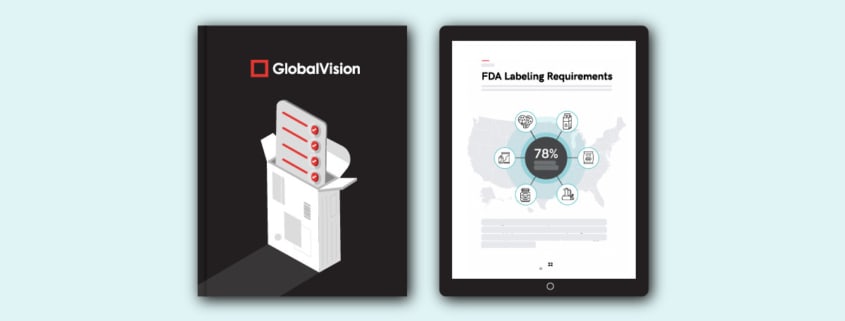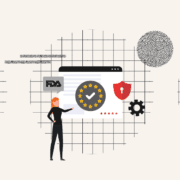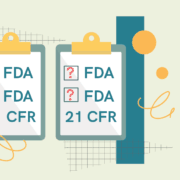How to Master FDA Labeling Requirements: Your Comprehensive Guide is Here
Date: April, 2023 | Category: Compliance | Author: Hana Trokic
For highly regulated industries, it’s crucial to understand and comply with the labeling requirements set by the Food and Drug Administration (FDA). However, navigating through complex regulations can be overwhelming, especially when guidelines are subject to constant and abrupt changes.
Thankfully, GlobalVision helps you to stay one step ahead of all regulations through our latest eBook, “Your Complete Guide to Meeting FDA Labeling Requirements.”
This comprehensive guide provides detailed insights into FDA labeling requirements and ensures your organization not only thoroughly understands labeling guidelines, but also sets best practices in place to consistently meet FDA labeling requirements with complete ease.
A Comprehensive Guide to FDA Labeling
From outlining requirements for specific products to detailing the formatting and content requirements for labels, our guide covers all crucial elements of labeling guidelines. We’ve distilled information into an easy-to-read format, complete with examples, statistics, infographics, and more to help you understand guidelines and apply them to your everyday quality assurance workflows.
Our eBook covers the following:
- FDA labeling guidelines for medical devices, drugs, pharmaceuticals, cosmetics, and food, and obstacles that arise when trying to maintain compliance
- How to meet all FDA labeling requirements with complete ease while ensuring the complete accuracy of your labels
- How regulated industries can implement best FDA labeling practices through automated quality control, including real-life case studies from industry-leading companies
FDA Officially Declared Plant-Based “Milk”, Milk
Just how quickly do FDA labeling requirements change? Taking notes from the recent cow milk vs. plant “milk” labeling battle, we can say, they can change overnight.
Back in 1973, the FDA defined milk as “the lacteal secretion, practically free from colostrum, obtained by the complete milking of one or more healthy cows.” In other words, milk, the original energy drink that we’ve known and loved for years, had to come from a lactating animal.
Fast forward to 2023 and things have drastically changed. The rise in vegan and plant-based diets has led to an overall shift in consumer behavior resulting in the growing need for a new, previously untapped market—offering alternative options to traditionally animal-derived products.
In recent years, this major pivot towards plant-based alternatives has slowly turned dairy aisles into everything but. Oat, soy, rice, coconut, cashew, hazelnut, and hemp are just a few alternatives that were labeled as “milk”.
Because of this, for years, dairy farmers and plant-based milk manufacturers saw themselves in a bitter fight over the name of their products. With the rising popularity of milk alternatives, dairy farmers have insisted that allowing these drinks to be labeled as “milk” is misleading. Up until recently, they were right. These plant-based alternatives weren’t legally allowed to be advertised as milk and had to be labeled as anything but to get an FDA stamp of approval.
Finally, as a true sign of the times, in February 2023, it became official. The FDA ruled that plant-based milk alternatives can use the term “milk” and millions of plant-milk manufacturers first rejoiced, and then found themselves in a flurry as they quickly needed to update their labels to reflect the new FDA guideline.
Keeping Up with FDA Labeling Requirements
The “milk” vs. milk case, is just one example of how FDA labeling requirements can change in an instant. These unexpected and often abrupt changes make keeping up with FDA guidelines anything but easy. The added worry of ensuring compliance to avoid costly fines, recalls, and potential harm to consumers is also an everyday obstacle for those in regulated industries.
Having a comprehensive guide that outlines all guidelines is a one-stop solution for relegated industries that want to ease these processes and alleviate the risks that come with errors in labeling and packaging. Our guide helps businesses navigate all these guidelines and more while streamlining proofreading and quality control processes, guaranteeing accurate, safe, and legal products that are ready for market and consumer use.
Whether you work in medical devices, drugs, pharmaceuticals, cosmetics, or food, GlobalVision’s eBook is sure to provide the information and answers needed to help your business stay compliant. Your Complete Guide to Meeting FDA Labeling Requirements is the ultimate resource for ensuring your products meet regulatory standards.
Don’t risk noncompliance with FDA labeling requirements – download our guide and start implementing best proofreading practices today.
———————————————————————————————————————————————————
Related Articles:
- Solving The Content Efficiency Problem in the Pharma Industry
- Ensure Your Labels Meet all FDA Drug Labeling Requirements with Automated Quality Control
- Overcome Your Content Challenges in Cosmetic Labeling to Meet FDA Requirements
- How to Ease the Labeling Proofreading Process for Medical Devices
- How to Ace FDA Food Label Compliance Review: Ensure Your Labels are Always Approved
Ensure your content is always error-free in record time with GlobalVision. Try it now for free.
Keep up with the latest updates in automated proofreading software. Sign up for our newsletter.









